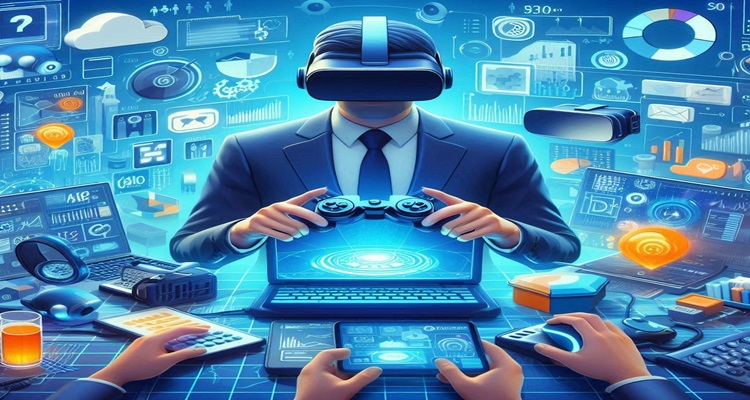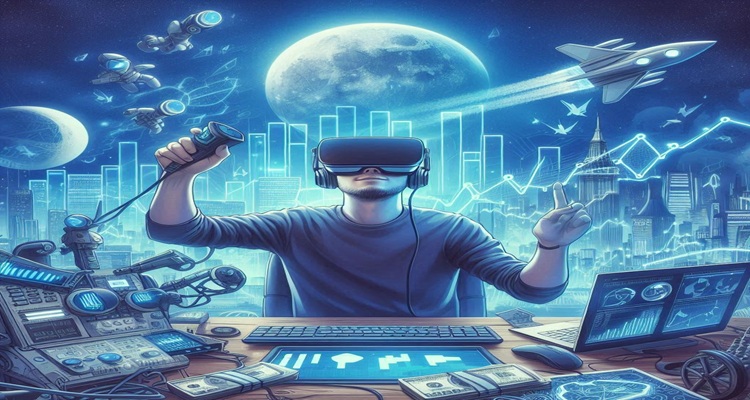The United States (USA) Virtual Reality Industry has emerged as a transformative force, reshaping how individuals interact with digital environments and revolutionizing sectors ranging from entertainment to healthcare. Virtual reality technology, often abbreviated as VR, allows users to immerse themselves in simulated worlds, offering experiences that blur the lines between the physical and digital realms. Over the past decade, the United States has positioned itself as a global leader in this innovative field, driven by cutting-edge research, substantial investments, and a robust ecosystem of companies pushing the boundaries of what VR can achieve.
The Economic Significance and Job Creation Within the United States (USA) Virtual Reality Industry
The economic impact of the United States (USA) Virtual Reality Industry cannot be overstated, as it contributes billions of dollars annually to the national economy while creating thousands of jobs. Major tech hubs like Silicon Valley in California, Seattle in Washington, and Austin in Texas have become epicenters for VR development, attracting talent and investment. Companies within the United States (USA) Virtual Reality Industry, ranging from startups to established corporations, employ engineers, designers, developers, and marketers, fostering a diverse workforce dedicated to advancing virtual reality technology.
In addition to direct employment, the United States (USA) Virtual Reality Industry stimulates growth in ancillary sectors, such as hardware manufacturing, software development, and content creation. For instance, the production of VR headsets like the Meta Quest and HTC Vive involves supply chains that span multiple states, supporting local economies and small businesses. Furthermore, the rise of VR applications in training and education has led to partnerships between industry players and academic institutions, particularly in states like Massachusetts and New York, where universities collaborate on cutting-edge VR research. This economic ripple effect underscores the United States (USA) Virtual Reality Industry’s role as a catalyst for innovation and prosperity.
The global virtual reality (VR) market size is estimated to be USD 15.9 billion in 2024 and is projected to reach USD 38.0 billion by 2029; it is expected to growing at a CAGR of 19.1% during the forecast period.
Download PDF Brochure @ https://www.marketsandmarkets.com/pdfdownloadNew.asp?id=458
Key Players and Innovators Shaping the United States (USA) Virtual Reality Industry
The United States (USA) Virtual Reality Industry thrives due to the contributions of key players who continue to push the envelope of what VR can achieve. Meta, headquartered in California, remains a dominant force, with its Oculus and Quest lines setting industry standards for consumer VR hardware. The company’s focus on standalone devices, which don’t require a tethered PC, has broadened access to virtual reality technology, making it a household name across the United States. Meanwhile, Unity Technologies, also based in California, powers much of the VR content ecosystem with its development engine, enabling creators to build immersive experiences for various platforms.
Beyond these giants, the United States (USA) Virtual Reality Industry benefits from a vibrant startup scene. Companies like Magic Leap in Florida and Niantic in California, known for augmented reality (AR) innovations that complement VR, contribute to the broader XR (extended reality) landscape. Additionally, firms like Penumbra in Alameda, California, are exploring VR’s therapeutic potential, particularly in healthcare settings. These innovators collectively drive the United States (USA) Virtual Reality Industry forward, ensuring it remains at the forefront of global technological advancement while addressing diverse societal needs.
State-Specific Contributions to the United States (USA) Virtual Reality Industry: California’s Leadership in VR Innovation
California stands as the undisputed leader within the United States (USA) Virtual Reality Industry, thanks to its concentration of tech giants, startups, and research institutions. Silicon Valley, located in the San Francisco Bay Area, serves as the heart of VR innovation, hosting companies like Meta, Unity Technologies, and countless smaller firms working on virtual reality technology. The state’s favorable business climate, access to venture capital, and proximity to top-tier universities like Stanford and UC Berkeley fuel its dominance. California’s contributions extend beyond hardware and software to include content creation, with Hollywood exploring VR as a medium for immersive storytelling.
The state’s role in the United States (USA) Virtual Reality Industry is further amplified by events like the Game Developers Conference (GDC) and Augmented World Expo (AWE), both held annually in California. These gatherings bring together developers, investors, and enthusiasts, fostering collaboration and showcasing the latest VR advancements. As a result, California not only drives technological progress within the United States (USA) Virtual Reality Industry but also sets trends that influence the global VR market, solidifying its status as a powerhouse in this domain.
Washington’s Role in VR Hardware and Software Development
Washington State plays a critical role in the United States (USA) Virtual Reality Industry, particularly through its contributions to VR hardware and software. Seattle, a major tech hub, is home to companies like Valve Corporation, which co-developed the HTC Vive, a leading VR headset known for its high-fidelity experiences. Valve’s expertise in gaming and software development has made it a key player in shaping the technical standards of the United States (USA) Virtual Reality Industry. Additionally, Microsoft, headquartered in Redmond, Washington, has ventured into the VR space with its HoloLens, a mixed reality device that complements traditional VR applications.
Washington’s tech ecosystem benefits from a skilled workforce and a culture of innovation, nurtured by institutions like the University of Washington. The state’s focus on hardware development, combined with its software prowess, positions it as a vital contributor to the United States (USA) Virtual Reality Industry. This synergy between hardware and software ensures that Washington remains a driving force in delivering cutting-edge VR solutions to consumers and businesses alike.
Texas and the Rise of VR in Education and Training
Texas has emerged as a significant player in the United States (USA) Virtual Reality Industry, particularly in the realms of education and training. Austin, often dubbed “Silicon Hills,” hosts a growing number of VR startups and established firms leveraging virtual reality technology for innovative applications. Companies like Owlchemy Labs, acquired by Google, have developed popular VR titles that blend entertainment with educational value, showcasing Texas’s influence in the industry. Moreover, the state’s robust educational infrastructure, including the University of Texas system, supports VR research and implementation in academic settings.
The United States (USA) Virtual Reality Industry benefits from Texas’s focus on practical applications, such as workforce training and simulation. Industries like oil and gas, prevalent in the state, utilize VR to train employees in high-risk environments without exposing them to real-world dangers. This pragmatic approach enhances the United States (USA) Virtual Reality Industry’s relevance, demonstrating how VR can address specific regional needs while contributing to national growth.
The Role of Virtual Reality Technology in Transforming Entertainment Within the United States (USA) Virtual Reality Industry
Entertainment remains one of the most prominent sectors transformed by the United States (USA) Virtual Reality Industry, with VR redefining how Americans consume media. Gaming, the initial catalyst for VR’s consumer adoption, continues to thrive, with titles like “Beat Saber” and “Half-Life: Alyx” showcasing the immersive potential of virtual reality technology. Major studios in California and Washington collaborate with VR developers to create experiences that captivate audiences, driving demand for VR headsets and accessories across the United States.
Beyond gaming, the United States (USA) Virtual Reality Industry is reshaping film and live events. Directors experiment with 360-degree storytelling, allowing viewers to step inside narratives, while companies like NextVR (now part of Apple) broadcast sports and concerts in VR, offering fans unparalleled access. This evolution highlights the United States (USA) Virtual Reality Industry’s ability to merge technology with creativity, enhancing entertainment options and setting new benchmarks for immersive experiences.
Healthcare Innovations Driven by the United States (USA) Virtual Reality Industry and Their Societal Impact
The United States (USA) Virtual Reality Industry has made significant inroads into healthcare, leveraging VR to improve patient outcomes and medical training. In states like California and Massachusetts, hospitals and research centers use virtual reality technology for surgical simulations, allowing doctors to practice complex procedures in a risk-free environment. Companies like Osso VR, based in California, lead this charge, providing platforms that enhance surgical precision and reduce errors, ultimately saving lives.
Moreover, the United States (USA) Virtual Reality Industry addresses mental health challenges through VR-based therapies. Applications like exposure therapy for PTSD and anxiety, developed by firms such as Limbix in California, offer patients immersive environments to confront and manage their conditions. This intersection of technology and healthcare exemplifies how the United States (USA) Virtual Reality Industry transcends entertainment, delivering tangible benefits to society and reinforcing its importance in modern medicine.
Educational Advancements and Workforce Training Fueled by the United States (USA) Virtual Reality Industry
Education and workforce development represent another frontier for the United States (USA) Virtual Reality Industry, with VR transforming how knowledge is imparted and skills are acquired. In states like Texas and New York, schools and universities integrate virtual reality technology into curricula, enabling students to explore historical events, dissect virtual organisms, or conduct physics experiments in simulated labs. This hands-on approach enhances engagement and retention, preparing the next generation for a tech-driven world.
The United States (USA) Virtual Reality Industry also revolutionizes professional training, particularly in high-stakes industries. For example, Boeing in Washington uses VR to train aerospace engineers, while Walmart employs it nationwide to upskill retail workers. These applications demonstrate the United States (USA) Virtual Reality Industry’s versatility, bridging educational gaps and equipping the workforce with tools to excel in an increasingly competitive landscape.
Challenges and Limitations Facing the United States (USA) Virtual Reality Industry in Its Quest for Mainstream Adoption
Despite its achievements, the United States (USA) Virtual Reality Industry faces challenges that hinder its path to widespread adoption. Cost remains a significant barrier, as high-end VR systems like the Valve Index or enterprise-grade solutions require substantial investment, limiting accessibility for many Americans. Additionally, technical issues such as motion sickness, experienced by some users due to latency or poor design, pose hurdles that the United States (USA) Virtual Reality Industry must overcome to ensure user comfort and satisfaction.
Privacy concerns also loom large, particularly as companies like Meta collect vast amounts of user data within VR environments. The United States (USA) Virtual Reality Industry must navigate these ethical dilemmas to maintain consumer trust. Furthermore, the lack of standardized hardware and software platforms complicates development, as creators must optimize content for multiple devices. Addressing these challenges is crucial for the United States (USA) Virtual Reality Industry to realize its full potential and achieve mainstream integration.
The Future Outlook and Emerging Trends in the United States (USA) Virtual Reality Industry
The future of the United States (USA) Virtual Reality Industry brims with promise, driven by emerging trends that signal its next phase of evolution. Advancements in hardware, such as lighter, more affordable headsets with improved resolution, will enhance accessibility and user experience. The integration of artificial intelligence (AI) into virtual reality technology, already underway in states like California, will enable more dynamic and personalized VR environments, from adaptive gaming worlds to tailored training simulations.
The United States (USA) Virtual Reality Industry is also poised to expand its role in the metaverse, a collective virtual space championed by Meta and other innovators. This concept, blending VR with AR and social networking, could redefine digital interaction, commerce, and community-building. As 5G networks roll out nationwide, low-latency connectivity will further elevate VR experiences, making them seamless and ubiquitous. These trends position the United States (USA) Virtual Reality Industry as a cornerstone of the future digital economy, with far-reaching implications for society.
The Lasting Legacy and Global Influence of the United States (USA) Virtual Reality Industry
The United States (USA) Virtual Reality Industry stands as a testament to human ingenuity, blending technological prowess with creative vision to reshape how we live, work, and play. From its early beginnings in research labs to its current status as a multi-billion-dollar market, the industry reflects the United States’ ability to lead and innovate on a global scale. States like California, Washington, and Texas, each with unique contributions, highlight the collaborative spirit driving this sector forward.
FAQs
- What is the United States (USA) Virtual Reality Industry, and how did it begin?
The United States (USA) Virtual Reality Industry encompasses the development, production, and application of virtual reality technology across various sectors. It began in the mid-20th century with early experiments like Ivan Sutherland’s “Ultimate Display” and evolved through military and NASA research in the 1980s and 1990s, eventually expanding into consumer markets with innovations like the Oculus Rift. - Which states are leading the United States (USA) Virtual Reality Industry?
California leads with Silicon Valley’s tech giants like Meta and Unity Technologies, followed by Washington with Valve and Microsoft, and Texas with its focus on VR in education and training. These states drive innovation and economic growth within the industry. - How does the United States (USA) Virtual Reality Industry impact the economy?
The industry contributes billions to the U.S. economy, creating jobs in tech hubs like Silicon Valley and Seattle, and supporting ancillary sectors like hardware manufacturing and content creation. Its growth fosters innovation and stimulates local economies nationwide. - What are the main applications of virtual reality technology in the United States (USA) Virtual Reality Industry?
Virtual reality technology is used in gaming, healthcare (e.g., surgical training, therapy), education (e.g., immersive learning), and workforce training (e.g., simulations for aerospace and retail), showcasing the industry’s versatility across multiple fields. - What challenges does the United States (USA) Virtual Reality Industry face?
Key challenges include high costs of VR hardware, motion sickness, privacy concerns related to data collection, and the need for standardized platforms, all of which must be addressed for the industry to achieve mainstream adoption.



